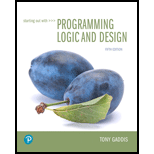
Starting Out with Programming Logic and Design (5th Edition) (What's New in Computer Science)
5th Edition
ISBN: 9780134801155
Author: Tony Gaddis
Publisher: PEARSON
expand_more
expand_more
format_list_bulleted
Expert Solution & Answer
Chapter 9, Problem 3AW
Explanation of Solution
Pseudocode explanation:
The variable “index”, “scan” and “unsortedValue” is declared as integer. The first element is compared with the next one and the comparison carried out till the last index. Assign “index” to “scan”. If the “array[scan-1] ” is less than the “array[scan]” then swap is performed for that particular pairs of element.
The given pseudocode performs the “Insertion sort
Insertion sort algorithm
- Sorting is a process to place the elements in order...
Expert Solution & Answer
Want to see the full answer?
Check out a sample textbook solution
Students have asked these similar questions
4. |z + 5 - 5i| = 7
14.
dz,
C: |z❘
C: |z❘ = 0.6
ze² - 2iz
H
14.
dz,
C: |z❘
C: |z❘ = 0.6
ze² - 2iz
H
Chapter 9 Solutions
Starting Out with Programming Logic and Design (5th Edition) (What's New in Computer Science)
Ch. 9.3 - Which of the sorting algorithms discussed makes...Ch. 9.3 - Prob. 9.2CPCh. 9.3 - Prob. 9.3CPCh. 9.4 - Prob. 9.4CPCh. 9.4 - On average, with an array of 1,000 elements, how...Ch. 9.4 - Prob. 9.6CPCh. 9 - Prob. 1MCCh. 9 - Prob. 2MCCh. 9 - Prob. 3MCCh. 9 - Prob. 4MC
Ch. 9 - Prob. 5MCCh. 9 - Prob. 6MCCh. 9 - Prob. 7MCCh. 9 - Prob. 8MCCh. 9 - Prob. 9MCCh. 9 - Prob. 10MCCh. 9 - Prob. 1TFCh. 9 - Prob. 2TFCh. 9 - Prob. 3TFCh. 9 - Prob. 4TFCh. 9 - Prob. 5TFCh. 9 - Prob. 1AWCh. 9 - Prob. 2AWCh. 9 - Prob. 3AWCh. 9 - What algorithm does the following pseudocode...Ch. 9 - Prob. 1SACh. 9 - Prob. 2SACh. 9 - Prob. 3SACh. 9 - Prob. 4SACh. 9 - Prob. 5SACh. 9 - Why is the selection sort more efficient than the...Ch. 9 - Prob. 7SACh. 9 - Prob. 8SACh. 9 - Assume the following main module is in a program...Ch. 9 - Prob. 1PECh. 9 - Sorted Names Design a program that allows the user...Ch. 9 - Rainfall Program Modification Recall that...Ch. 9 - Name Search Modify the Sorted Names program that...Ch. 9 - Charge Account Validation Recall that Programming...Ch. 9 - Prob. 7PECh. 9 - Sorting Benchmarks Modify the modules presented in...
Knowledge Booster
Similar questions
arrow_back_ios
SEE MORE QUESTIONS
arrow_forward_ios
Recommended textbooks for you
 EBK JAVA PROGRAMMINGComputer ScienceISBN:9781337671385Author:FARRELLPublisher:CENGAGE LEARNING - CONSIGNMENT
EBK JAVA PROGRAMMINGComputer ScienceISBN:9781337671385Author:FARRELLPublisher:CENGAGE LEARNING - CONSIGNMENT C++ Programming: From Problem Analysis to Program...Computer ScienceISBN:9781337102087Author:D. S. MalikPublisher:Cengage Learning
C++ Programming: From Problem Analysis to Program...Computer ScienceISBN:9781337102087Author:D. S. MalikPublisher:Cengage Learning Microsoft Visual C#Computer ScienceISBN:9781337102100Author:Joyce, Farrell.Publisher:Cengage Learning,
Microsoft Visual C#Computer ScienceISBN:9781337102100Author:Joyce, Farrell.Publisher:Cengage Learning,- Programming Logic & Design ComprehensiveComputer ScienceISBN:9781337669405Author:FARRELLPublisher:Cengage
 Systems ArchitectureComputer ScienceISBN:9781305080195Author:Stephen D. BurdPublisher:Cengage Learning
Systems ArchitectureComputer ScienceISBN:9781305080195Author:Stephen D. BurdPublisher:Cengage Learning C++ for Engineers and ScientistsComputer ScienceISBN:9781133187844Author:Bronson, Gary J.Publisher:Course Technology Ptr
C++ for Engineers and ScientistsComputer ScienceISBN:9781133187844Author:Bronson, Gary J.Publisher:Course Technology Ptr

EBK JAVA PROGRAMMING
Computer Science
ISBN:9781337671385
Author:FARRELL
Publisher:CENGAGE LEARNING - CONSIGNMENT

C++ Programming: From Problem Analysis to Program...
Computer Science
ISBN:9781337102087
Author:D. S. Malik
Publisher:Cengage Learning

Microsoft Visual C#
Computer Science
ISBN:9781337102100
Author:Joyce, Farrell.
Publisher:Cengage Learning,

Programming Logic & Design Comprehensive
Computer Science
ISBN:9781337669405
Author:FARRELL
Publisher:Cengage

Systems Architecture
Computer Science
ISBN:9781305080195
Author:Stephen D. Burd
Publisher:Cengage Learning

C++ for Engineers and Scientists
Computer Science
ISBN:9781133187844
Author:Bronson, Gary J.
Publisher:Course Technology Ptr